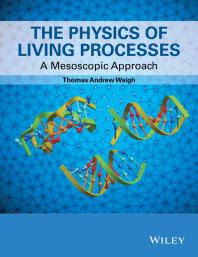书目详情:
The Physics of Living Processes: A Mesoscopic ApproachCopyrightContentsPrefaceAcknowledgementsPart I: Building Blocks1 Molecules1.1 Chemical Bonds and Molecular Interactions1.2 Chirality1.3 Proteins1.4 Lipids1.5 Nucleic Acids1.6 Carbohydrates1.7 Water1.8 Proteoglycans and Glycoproteins1.9 Viruses1.10 Other MoleculesSuggested ReadingTutorial Questions 12 Cells2.1 The First Cell2.2 Metabolism2.3 Central Dogma of Biology2.4 Darwin’s Theory of Natural Selection2.5 Mutations and Cancer2.6 Prokaryotic Cells2.7 Eukaryotic Cells2.8 Chromosomes2.9 Cell Cycle2.10 Genetic Code2.11 Genetic Networks2.12 Human Genome Project2.13 Genetic Fingerprinting2.14 Genetic Engineering2.15 Tissues2.16 Cells as Experimental Models2.17 Stem CellsSuggested ReadingTutorial Questions 2Part II Soft Condensed-Matter Techniques in Biology3 Introduction to Statistics in Biology3.1 Statistics3.2 Entropy3.3 Information3.4 Free Energy3.5 Partition Function3.6 Conditional Probability3.7 NetworksSuggested ReadingTutorial Questions 34 Mesoscopic Forces4.1 Cohesive Forces4.2 Hydrogen Bonding4.3 Electrostatics4.3.1 Unscreened Electrostatic Interactions4.3.2 Screened Electrostatic Interactions4.3.3 The Force Between Charged Aqueous Spheres4.4 Steric and Fluctuation Forces4.5 Depletion Forces4.6 Hydrodynamic Interactions4.7 Bell’s Equation4.8 Direct Experimental MeasurementsSuggested ReadingTutorial Questions 45 Phase Transitions5.1 The Basics5.2 Helix–Coil Transition5.3 Globule–Coil Transition5.4 Crystallisation5.5 Liquid–Liquid Demixing Phase Separation)Suggested ReadingTutorial Questions 56 Liquid Crystallinity6.1 The Basics6.2 Liquid Nematic–Smectic Transitions6.3 Defects6.4 More Exotic Possibilities for Liquid-Crystalline PhasesSuggested ReadingTutorial Questions 67 Motility7.1 Diffusion7.2 Low Reynolds Number Dynamics7.3 Motility of Cells and Micro-Organisms7.4 First-Passage Problem7.5 Rate Theories of Chemical Reactions7.6 SubdiffusionSuggested ReadingTutorial Questions 78 Aggregating Self-Assembly8.1 Surface-Active Molecules Surfactants)8.2 Viruses8.3 Self-Assembly of Proteins8.4 Polymerisation of Cytoskeletal Filaments Motility)Suggested ReadingTutorial Questions 89 Surface Phenomena9.1 Surface Tension9.2 Adhesion9.3 Wetting9.4 Capillarity9.5 Experimental Techniques9.6 Friction9.7 Adsorption Kinetics9.8 Other Physical Surface PhenomenaSuggested ReadingTutorial Questions 910 Biomacromolecules10.1 Flexibility of Macromolecules10.2 Good/Bad Solvents and the Size of Flexible Polymers10.3 Elasticity10.4 Damped Motion of Soft Molecules10.5 Dynamics of Polymer Chains10.6 Topology of Polymer Chains – SupercoilingSuggested ReadingTutorial Questions 1011 Charged Ions and Polymers11.1 Electrostatics11.2 Deybe–Huckel Theory11.3 Ionic Radius11.4 The Behaviour of Polyelectrolytes11.5 Donnan Equilibria11.6 Titration Curves11.7 Poisson–Boltzmann Theory for Cylindrical Charge Distributions11.8 Charge Condensation11.9 Other Polyelectrolyte PhenomenaSuggested ReadingTutorial Questions 1112 Membranes12.1 Undulations12.2 Bending Resistance12.3 Elasticity12.4 Intermembrane Forces12.5 Passive/Active Transport12.6 VesiclesSuggested ReadingTutorial Questions 1213 Continuum Mechanics13.1 Structural Mechanics13.2 Composites13.3 Foams13.4 Fracture13.5 MorphologySuggested ReadingTutorial Questions 1314 Fluid Mechanics14.1 Newton’s Law of Viscosity14.2 Navier–Stokes Equations14.3 Pipe Flow14.4 Vascular Networks14.5 Haemodynamics14.6 Circulatory Systems14.7 LungsSuggested ReadingTutorial Questions 1415 Rheology15.1 Storage and Loss Moduli15.2 Rheological Functions15.3 Examples from Biology: Neutral Polymer Solutions, Polyelectrolytes, Gels, Colloids, Liquid Crystalline Polymers, Glasses, Microfluidics15.3.1 Neutral Polymer Solutions15.3.2 Polyelectrolytes15.3.3 Gels15.3.4 Colloids15.3.5 Liquid-Crystalline Polymers15.3.6 Glassy Materials15.3.7 Microfluidics in Channels15.4 Viscoelasticity of the CellSuggested ReadingTutorial Questions 1516 Motors16.1 Self-Assembling Motility – Polymerisation of Actin and Tubulin16.2 Parallelised Linear Stepper Motors – Striated Muscle16.3 Rotatory Motors16.4 Ratchet Models16.5 Other SystemsSuggested ReadingTutorial Questions 1617 Structural Biomaterials17.1 Cartilage – Tough Shock Absorbers in Human Joints17.2 Spider Silk17.3 Elastin and Resilin17.4 Bone17.5 Adhesive Proteins17.6 Nacre and Mineral CompositesSuggested ReadingTutorial Questions 1718 Phase Behaviour of DNA18.1 Chromatin – Naturally Packaged DNA Chains18.2 DNA Compaction – An Example of Polyelectrolyte Complexation18.3 Facilitated DiffusionSuggested ReadingPart III Experimental Techniques19 Experimental Techniques19.1 Mass Spectroscopy19.2 Thermodynamics19.2.1 Differential Scanning Calorimetry19.2.2 Isothermal Titration Calorimetry19.2.3 Surface Plasmon Resonance and Interferometry-Based Biosensors19.3 Hydrodynamics19.4 Optical Spectroscopy19.4.1 Rayleigh Scattering19.4.2 Brillouin Scattering19.4.3 Terahertz/Microwave Spectroscopy19.4.4 Infrared Spectroscopy19.4.5 Raman Spectroscopy19.4.6 Nonlinear Spectroscopy19.4.7 Circular Dichroism and UV Spectroscopy19.5 Optical Microscopy19.5.1 Fluorescence Microscopy19.5.2 Super-Resolution Microscopy19.5.3 Nonlinear Microscopy19.5.4 Polarisation Microscopy19.5.5 Optical Coherence Tomography19.5.6 Holographic Microscopy19.5.7 Other Microscopy Techniques19.6 Single-Molecule Detection19.7 Single-Molecule Mechanics and Force Measurements19.8 Electron Microscopy19.9 Nuclear Magnetic Resonance Spectroscopy19.10 Static Scattering Techniques19.11 Dynamic Scattering Techniques19.12 Osmotic Pressure19.13 Chromatography19.14 Electrophoresis19.15 Sedimentation19.16 Rheology19.17 Tribology19.18 Solid Mechanical PropertiesSuggested ReadingTutorial Questions 19Part IV Systems Biology20 Chemical Kinetics20.1 Conservation Laws20.2 Free Energy20.3 Reaction Rates20.4 Consecutive Reactions20.5 Case I and II Reactions20.6 Parallel Reactions20.7 Approach to Chemical Equilibrium20.8 Quasi-Steady-State Approximation20.9 General Kinetic Equation AnalysisSuggested ReadingTutorial Questions 2021 Enzyme Kinetics21.1 Michaelis–Menten Kinetics21.2 Lineweaver–Burke Plot21.3 Enzyme Inhibition21.4 Competitive Inhibition21.5 Allosteric Inhibition21.6 Cooperativity21.7 Hill Plot21.8 Single Enzyme MoleculesSuggested ReadingTutorial Questions 2122 Introduction to Systems Biology22.1 Integrative Model of the Cell22.2 Transcription Networks22.3 Gene Regulation22.4 Lac Operon22.5 Repressilator22.6 Autoregulation22.7 Network Motifs22.8 Robustness22.9 Morphogenesis22.10 Kinetic Proofreading22.11 Temporal Programs22.12 Nonlinear Models22.13 Population DynamicsSuggested ReadingTutorial Questions 22Part V Spikes, Brains and the Senses23 Spikes23.1 Structure and Function of a Neuron23.2 Membrane Potential23.3 Ion Channels23.4 Voltage Clamps and Patch Clamps23.5 Nernst Equation23.6 Electrical Circuit Model of a Cell Membrane23.7 Cable Equation23.8 Hodgkin–Huxley Model23.9 Action Potential23.10 Spikes – Travelling Electrical Waves23.11 Cell SignallingSuggested ReadingTutorial Questions 2324 Physiology of Cells and Organisms24.1 Feedback Loops24.2 Nonlinear Behaviour24.3 Potential Outside an Axon24.4 Electromechanical Properties of the Heart24.5 Electrocardiogram24.6 ElectroencephalographySuggested ReadingTutorial Questions 2425 The Senses25.1 Biological Senses25.2 Weber’s Law25.3 Information Processing and Hyperacuity25.4 Mechanoreceptors25.5 Chemoreceptors25.6 Photoreceptors25.7 Thermoreceptors25.8 Electroreceptors25.9 MagnetoreceptorsSuggested ReadingTutorial Questions 2526 Brains26.1 Neural Encoding Inverse Problem26.2 Memory26.3 Motor Processes26.4 Connectome26.5 Cohesive PropertiesSuggested ReadingTutorial Questions 26Appendix A Physical ConstantsAppendix B Answers to Tutorial QuestionsIndex
评论:







